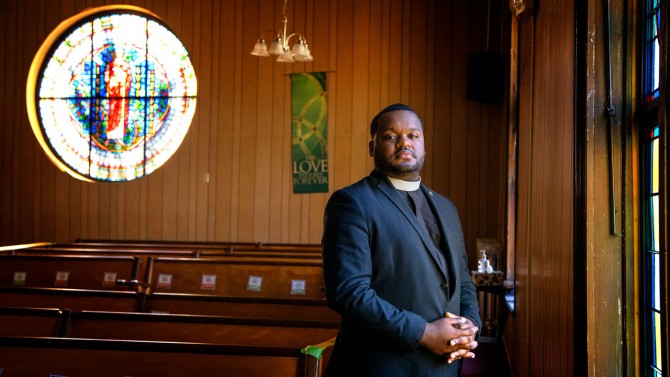Khalil Hicks, age 11, straddles a 3-foot square trench and points his trowel at the spot where he and his fellow archaeologists discovered an unexpected treasure - right near the stone foundation of St. James A.M.E. Zion Church, Ithaca's most important Underground Railroad station.
Hicks was on sifting duty that day. At first he thought the compacted dirt in his sifting tray held nothing more than a rock. "Then I see a nail coming out," he says. "I lifted it up in the sunlight and boom - a door hinge! Everybody was cheering on, because I had found something really big."
It was the latest find at an excavation site where community members and a multidisciplinary team of Cornell faculty and students have been collaborating to learn more about St. James.
"The church is a treasure trove of history and we haven't even scratched the surface," says Rev. Terrance King, pastor of St. James.
The Rev. Terrance King, pastor of St. James A.M.E. Zion Church in Ithaca, says the excavation at St. James has sparked a renewed interest in the church's rich abolitionist history.
Built in 1833, the church could almost be mistaken for another residence on Cleveland Avenue in Ithaca's Southside community. But St. James boasts a list of remarkable distinctions.
It is believed to be the oldest religious structure in Ithaca. It is the world's oldest active A.M.E. Zion church, a denomination known as "the freedom church" because of its role in the abolition movement. St. James hosted abolitionists including Frederick Douglass, who spoke there in 1852, and possibly Harriet Tubman, who visited Ithaca several times, had family members in the area and was a member of the denomination.
But much of the church's history remains unknown - like whether there's any truth to the rumor it sheltered enslaved freedom-seekers in a secret hiding place or tunnel.
Teams of local middle- and high school students, alongside Cornell faculty and students, spent Saturdays from Sept. 18 to Nov. 13 digging in five trenches on a small lawn next to the church where the original parsonage once stood. Neighbors frequently stopped by to check on their progress and even do some digging themselves.
"You can only do this as a team," says Adam T. Smith, Distinguished Professor of Arts and Sciences in Anthropology in the College of Arts and Sciences (A&S), who is co-leading the excavation with Lori Khatchadourian, associate professor of Near Eastern studies (A&S). "It's not just that we're revealing the history of this community. We're actually building community."







